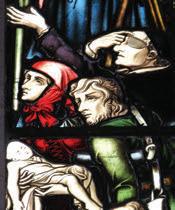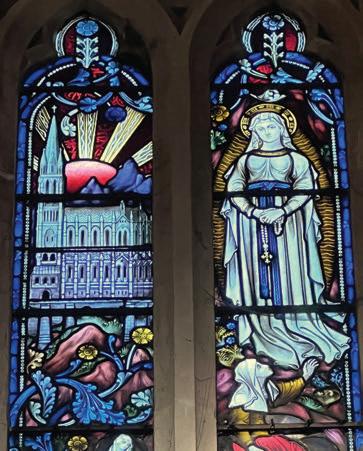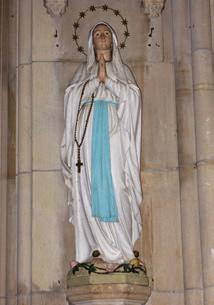FRIENDS of ARUNDEL CATHEDRAL
Spring 2023

 Bernadette Soubirous, prior to her joining the Sisters of Charity in the motherhouse at Nevers.
Bernadette Soubirous, prior to her joining the Sisters of Charity in the motherhouse at Nevers.

Dear Friends
How appropriate it was that the autumn tour of the relic of St Bernadette should have included a period of veneration in Arundel Cathedral. Duke Henry, builder of the Cathedral, had a particular devotion to Lourdes, as shown in the stained glass window at the side of the Lady Chapel. Bernadette Soubirous and Henry Fitzalan Howard were near contemporaries; in terms of age she could have been an older sister. though in terms of background there could hardly have been a greater gulf than between the impoverished miller’s daughter in southern France and the future Earl Marshal of England. Henry was eleven years old at the time of the Apparitions of Lourdes. By the time he was travelling in Europe following his education at the Oratory School in Birmingham, the Apparitions had been authenticated by the Bishop of Tarbes, and Henry was likely to have known of the site.
Might he have visited Lourdes at that time? I have a wholly fanciful idea of a meeting in the street, the rather short and famously scruffy Duke coming across the diminutive and poorly dressed young woman, not yet herself the object of any sort of veneration. Had they spoken they would have conversed in French, a second language for both, as Bernadette would have spoken Occitan at home. An utterly improbable event, I’m afraid, but had such a meeting occurred we can be sure the young Englishman would have treated Bernadette with the same perfect courtesy he would have extended to a Duchess.
This year sees the 150th anniversary of the opening of Duke Henry’s church. The Friends have arranged for the publication of a facsimile edition of the monograph on the Cathedral written by Francis Steer on the occasion of its centenary, which will be available in good time for the summer celebrations. We have much to be thankful for, both for the initial building of the church and the continuing life of the parish and diocese. At the time of writing preparations are under way for this year’s A&B Lourdes pilgrimage, and we include in this issue Canon David’s reflections as Spiritual Director for the event.
Oliver Hawkins Editor

Embroidered banner of Our Lady of Lourdes (detail on front cover), commissioned by Duke Henry, probably in the 1880s or 1890s, to be carried in procession. Bernadette herself was a skilled needlewoman and worked as a sacristan in her convent, creating beautiful embroidery for altar cloths and vestments.

PILGRIMAGE
In 1866 Bernadette left Lourdes to live the rest of her short life with the Sisters of Charity in Nevers, and it was only many years after Henry’s death that she was canonised. But the shrine at Lourdes very quickly became a centre for pilgrimage, and in due course Henry, married to Duchess Flora (pictured above) and with a severely disabled young child, became a regular pilgrim. The fine stained glass window must have been added to the Cathedral some time after its completion, as it shows the Duke and Duchess leading their little boy to the Grotto. Their son Philip is depicted as an able-bodied, if frail, young boy; wishful thinking on behalf of the devoted parents. A touching episode during one of their visits was described by a friend. A group was heard singing the Magnificat, and Duchess Flora turned to her companions in tears, ‘He hath filled the hungry with good things’, she said, ‘and the rich he hath sent empty away. We are the rich; we will have nothing.’
Philip was to enjoy no miraculous healing, and Flora herself died at the age of thirty-four, leaving Duke Henry to look after his helpless little son for another fifteen years.
THE LOURDES WINDOW
In planning the Cathedral Duke Henry must have given a great deal of thought to the windows: which themes to feature, and which saints to include. Around one hundred individuals can be identified, including two dozen packed into the window of Royal Saints, above what is now the shop. The Lourdes window is significantly different in that it represents a contemporary scene, though the pilgrims are dressed in a style that could pass for medieval. The halt and the lame cry out; a woman in green is seen dropping a coin into the hat of a beggar, and in a group of pilgrims immediately above the Duke and Duchess (opposite) can be seen a Carmelite nun and a Sister of Charity, in reference to the two sisters of the Duke who had embraced the religious life.
Duke Henry, a thoroughly practical man, was aware that his devotion to Lourdes would seem strange to others: ‘This will seem foolishness to most of those who are not of our faith, who will wonder that a man who in other respects maintained such sturdy common sense, should in this one respect have yielded to an inexplicable superstition.’
He was conscious also that too public a display risked inflaming the anti-catholic sentiment that was never far from the surface in Victorian England, and took the cautionary step of gathering his party of pilgrims for departure from Paris rather than London.




The top section of the Lourdes window shows on the left side the Basilica of the Immaculate Conception, consecrated in 1876, with the Pyrenees mountains and a dramatic sunrise behind. On the right is the figure of Our Lady of Lourdes, dressed in white with a blue sash as described by Bernadette, and holding a rosary. This traditional representation is also used in the statue (opposite) at the entrance to the Lady Chapel.

The pilgrimage that Duke Henry instituted has transformed over the years into the Arundel and Brighton Diocesan Pilgrimage, an annual event now involving around seven hundred pilgrims, some sick, some helping.
A stalwart over many years was Duke Henry’s grand-daughter Sarah, who took over as co-ordinator of the A&B pilgrimage in 1977, and whose unfailing energy, enthusiasm and care are still warmly remembered. A scene that exemplified Sarah’s practical powers of persuasion involved stri king French railway workers. The train carrying the pilgrims is at a standstill in northern France, piles of burning debris blocking the tracks and no prospect of a resolution to the industrial action. The slight figure of an Eng lishwoman is to be seen picking her way through the mayhem, a conversation takes place with the grevistes, there are shrugs and smiles and in a moment the militants are removing the blockages and allowing a single train to progress. Sarah has her party back on track. Duke Henry, whose approach was always to deal with people in person, would have applauded heartily. Whether he would have allowed himself to applaud the tradition, sadly discontinued, of throwing the Bishop into the river at Lourdes during the pilgrimage we can’t say.
REFLECTIONS ON THE A&B LOURDES PILGRIMAGE
Canon David Parmiter, Cathedral Dean
I became involved in our Diocesan Pilgrimage before I was ordained a Priest and volunteered as a helper along with many others. We were travelling to Lourdes by train as Oliver mentions and we were assigned to our hotel group once on board. Lady Sarah and her team organised the pilgrims into groups of about 60 -80 and they stayed in different hotels in the town. Your hotel group was a small ‘family’ unit where help and care could be given to those who were sick and frail, prayer could take place and community experienced, including socialising at events like party night. Each day the whole pilgrimage would join together in the Shrine for Mass, the processions and other services. That structure, with one or two minor changes, is still in place today.
Like all things in life, change has taken place, and the pilgrimage continues to evolve. One noticeable change that has taken place in recent years, is the group of young people in school years 10 and 11 who are part of a group called the Red Shirts. Although still too young to be helpers, that comes when you reach school year 12, these young people serve the pilgrimage in a different way. These 15 and 16 year olds carry out the ministry of welcome at the pilgrimage services, learn about Lourdes and the value of service to those who are sick and in need of care and receive formation in faith and prayer. When the time comes they are able to take on the duties of a helper and enable those they serve to make a good pilgrimage to the shrine by providing practical and spiritual help.
The main purpose of the pilgrimage remains, as in Lady Sarah’s time, to enable those who are not able to make the pilgrimage to Lourdes alone to do so as part of a bigger group. This larger collection of pilgrims includes teams of doctors and nurses, clergy, lay chaplains and musicians all based in the smaller hotel groups. The catering and laundry teams are based in the Accueil, a place of welcome similar to a hospital, which is based within the grounds of the shrine and used for around 20 – 30 pilgrims who are not able to stay in a hotel group because of their needs for care. Travel to Lourdes is no longer by train as that the carriages are no longer available. So we journey by Jumbulance, by air and coach and will do again this year sure that Our Lady of Lourdes and St. Bernadette will intercede for us and those we carry to the Shrine in our hearts and minds.
 The 2008 Carpet of Flowers, celebrating the 150th anniversary of the apparitions at Lourdes.
The 2008 Carpet of Flowers, celebrating the 150th anniversary of the apparitions at Lourdes.







The Friends of Arundel Cathedral registered as a company
Limited by guarantee and not having a share capital (No 3792834)
Registered Charity No 1078149
The Friends’ Office, Cathedral House, Parsons Hill, Arundel, West Sussex BN18
Telephone: 01903 884567, Email: aruncathfriends@btconnect.com
9AY

 Bernadette Soubirous, prior to her joining the Sisters of Charity in the motherhouse at Nevers.
Bernadette Soubirous, prior to her joining the Sisters of Charity in the motherhouse at Nevers.









 The 2008 Carpet of Flowers, celebrating the 150th anniversary of the apparitions at Lourdes.
The 2008 Carpet of Flowers, celebrating the 150th anniversary of the apparitions at Lourdes.





